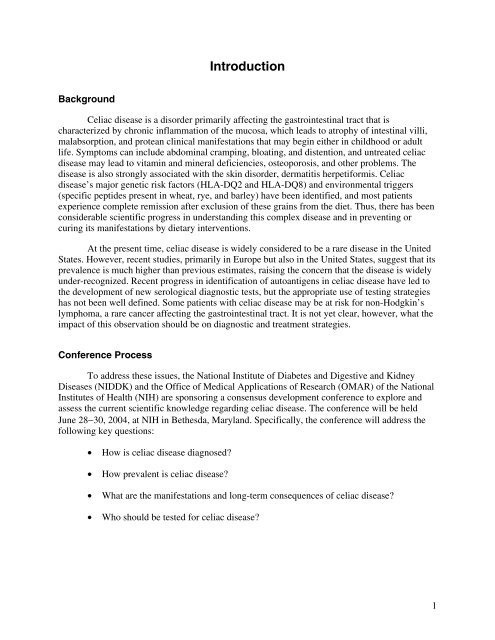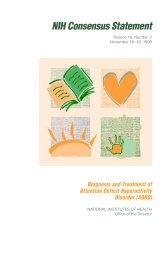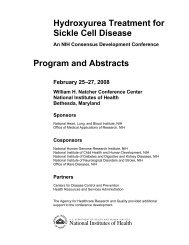Celiac Disease - NIH Consensus Development Program - National ...
Celiac Disease - NIH Consensus Development Program - National ...
Celiac Disease - NIH Consensus Development Program - National ...
Create successful ePaper yourself
Turn your PDF publications into a flip-book with our unique Google optimized e-Paper software.
Introduction Background<strong>Celiac</strong> disease is a disorder primarily affecting the gastrointestinal tract that ischaracterized by chronic inflammation of the mucosa, which leads to atrophy of intestinal villi,malabsorption, and protean clinical manifestations that may begin either in childhood or adultlife. Symptoms can include abdominal cramping, bloating, and distention, and untreated celiacdisease may lead to vitamin and mineral deficiencies, osteoporosis, and other problems. Thedisease is also strongly associated with the skin disorder, dermatitis herpetiformis. <strong>Celiac</strong>disease’s major genetic risk factors (HLA-DQ2 and HLA-DQ8) and environmental triggers(specific peptides present in wheat, rye, and barley) have been identified, and most patientsexperience complete remission after exclusion of these grains from the diet. Thus, there has beenconsiderable scientific progress in understanding this complex disease and in preventing orcuring its manifestations by dietary interventions.At the present time, celiac disease is widely considered to be a rare disease in the UnitedStates. However, recent studies, primarily in Europe but also in the United States, suggest that itsprevalence is much higher than previous estimates, raising the concern that the disease is widelyunder-recognized. Recent progress in identification of autoantigens in celiac disease have led tothe development of new serological diagnostic tests, but the appropriate use of testing strategieshas not been well defined. Some patients with celiac disease may be at risk for non-Hodgkin’slymphoma, a rare cancer affecting the gastrointestinal tract. It is not yet clear, however, what theimpact of this observation should be on diagnostic and treatment strategies.Conference ProcessTo address these issues, the <strong>National</strong> Institute of Diabetes and Digestive and Kidney<strong>Disease</strong>s (NIDDK) and the Office of Medical Applications of Research (OMAR) of the <strong>National</strong>Institutes of Health (<strong>NIH</strong>) are sponsoring a consensus development conference to explore andassess the current scientific knowledge regarding celiac disease. The conference will be heldJune 28−30, 2004, at <strong>NIH</strong> in Bethesda, Maryland. Specifically, the conference will address thefollowing key questions:• How is celiac disease diagnosed?• How prevalent is celiac disease?• What are the manifestations and long-term consequences of celiac disease?• Who should be tested for celiac disease?1







